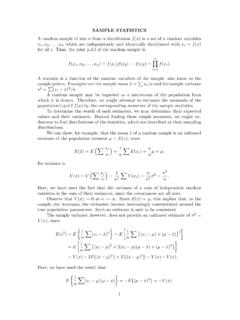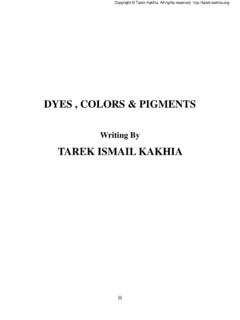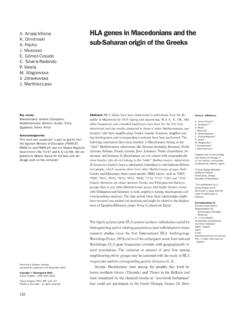Transcription of LATE MESOLITHIC AND BEAKER ASSEMBLAGES FROM …
1 Trans. Leicestershire Archaeol. and Hist. Soc., 86 (2012)LATE MESOLITHIC AND BEAKER ASSEMBLAGES FROM excavations AT loughborough road , ASFORDBYW ayne Jarviswith contributions from: Matthew Beamish, Lynden Cooper, Nicholas J. Cooper, Angela Monckton, Harriet Anne Jacklin, G ran Possnert and Ingela Sundstr mBetween 2009 and 2011, archaeological excavations were carried out by University of Leicester Archaeological Services (ULAS) on a site at loughborough road , asfordby , Leicestershire (SK 701 192), which revealed traces of activity dating to the MESOLITHIC , Late Neolithic Early Bronze Age and Iron Age periods. The work was carried out on behalf of Jelson Ltd, in advance of and during residential development of the site.
2 This report highlights evidence of Late Neolithic Early Bronze Age occupation which yielded a significant assemblage of worked flint, and the largest assemblage of BEAKER pottery found so far in Leicestershire, and of earlier occupation in the form of a Late MESOLITHIC lithic assemblage preserved in a tree throw hole. The site archive will be held with Leicestershire County Council, under the accession number 2008. INTRODUCTIOND uring excavations carried out in advance of residential development at loughborough road , asfordby , Leicestershire, archaeological activity was identified from the MESOLITHIC , Late Neolithic Early Bronze Age and Iron Age periods.
3 The site is located on the north-west edge of asfordby village, to the south of the A6006 and on the north-east side of loughborough road at NGR SK 701 192 (Fig. 1). It covers an area of , which had been undeveloped pasture since the late nineteenth century. The site lies at a height of between OD at the west and in the centre-north of the site, where there is a slight crest. This crest is part of a small plateau which continues to the north and east, whereas the land below slopes down most noticeably to the west and south. The site lies on glacial till (also known as boulder clay) overlying impermeable Mesozoic geology consisting of Blue Lias (Scunthorpe Mudstone Formation, Ordnance Survey Geology map Sheet 142, Melton Mowbray).
4 The drift comprises a dome-shaped feature, with a core of Birstall sand and gravel (BISG) at the crest of the field which is surrounded by Thrussington till (THT) at the edges of the site area. The drift material incorporates occasional nodules of derived East Anglian flint, material suitable for flint working. McPhail reports that the soils are broadly stagnogleyic argillic brown earths (Oxpasture soil series; Hodge et al. 1983) formed in loamy drift (McPhail 2010). 128/08/2012 10:042 wayne jarvisFollowing a geophysical survey (Smalley 2007) and trial trench evaluation of the site (Parker 2008), three areas of archaeological potential were identified, providing evidence of MESOLITHIC , Late Neolithic Early Bronze Age and Iron Age activity (Fig.)
5 2). Area 1, located in the west of the site, included a range of cut features associated with BEAKER pottery. Area 2, located to the north-east (trench 1, Fig. 3), contained a colluvial deposit associated with a MESOLITHIC flint scatter potentially in a primary context. Area 3, located to the south-east, contained Fig. 1. Location. Reproduced from the OS Landranger 1:50,000 map 129 Nottingham and loughborough area. By permission of Ordnance Survey on behalf of The Controller of Her Majesty s Stationery Office. Crown Copyright 1996. All rights reserved. Licence number AL 228/08/2012 10:04late MESOLITHIC and BEAKER ASSEMBLAGES at loughborough road 3other ephemeral features including possible tree throw holes.
6 These three areas were subject to full excavation following the recommendations of the Principal Planning Archaeologist at Leicestershire County Council, acting as advisor to the planning authority. All areas were stripped of overburden using a 360 excavator with toothless ditching bucket. Areas 1 and 3 were stripped of both topsoil and subsoil to reveal archaeological features prior to their hand excavation. Only limited machine-reduction of Area 2 was undertaken before test-pitting, and hand excavation with 3D recording of artefacts. This method helped to identify a potential MESOLITHIC buried soil which survived in a shallow hollow or valley in the east of the site that was later infilled by colluvium.
7 The full MESOLITHIC results from the buried soil are still in analysis and are to be published at a later stage (Cooper and Jarvis forthcoming).RESULTSArea 1 revealed a small rectangular structure to the north, a gully aligned east-west to the south and two pits, while to the east were further discrete features including a small cremation pit (Fig. 3). In Area 2, the colluvium was cut by a gully, pits and tree throw holes (Fig. 9), while in Area 3 two tree throw holes and a pit containing Iron Age material were revealed (Fig. 10). Cut features are referred to here in square brackets ( [58]) while their fills are shown with round brackets ( (251)).Fig. 2. Site main areas including trench numbers referred to in 328/08/2012 10:044 wayne jarvisThe most significant features from Area 1 were two pits [58] and [100] that contained BEAKER pottery and contemporary worked flint.
8 Pit [58] was oval to sub-rectangular in plan, measuring north-west to south-east by north-east to south-west, and was deep (Figs 4 6). The primary fill (251) consisted of a clean orangey grey silty-clay, probably initial silting. Above this was a pale (leached) grey silty-clay with frequent pebbles and charcoal containing worked flint and pottery (250) and (241), a grey orange silty-clay also with frequent pebbles again containing worked flint. Above these contexts, (245) was a fill of brown orange silty-clay with patches of pure clay, while (165) consisted of a mid-grey clayey silt with occasional pebbles and charcoal, containing pottery and worked flint.
9 This was in turn sealed by (244), a pale grey silty-clay with occasional pebbles and patches of pure clay and again containing worked flint. Above this, (147) was a light grey clay-silt fill some thick with occasional pottery, charcoal and burnt stones, other unburnt pebbles and pure clay patches towards its base. A concentration of flint was recovered from this fill. The uppermost fill was (57), a mid-grey brown clay-silt, which contained a concentration of charcoal, worked flint and pottery. Pit [100] was located to the south-west of Area 1 and 17m to the south-west of pit [58] (Figs 4; 6 7). It was oval in shape being slightly elongated north-west to south-east and measured north-west to south-east, east-west, and in depth.
10 Therefore, although it was comparable to pit [58] in form , it was much smaller and considerably shallower. The primary fill (218) was a light reddish to greyish-brown loamy clay with frequent pebbles, and occasional charcoal. Fig. 3. Area 1 general plan showing spread of 428/08/2012 10:04late MESOLITHIC and BEAKER ASSEMBLAGES at loughborough road 5 Above this, (216) consisted of a light greyish-brown loamy-clay with occasional pebbles and charcoal flecks. This fill contained a large rusticated BEAKER (Fig. 11 vessel 1, (217)) along with worked flint. A radiocarbon date of 2280 2030 cal BC (Ua-41784; 3,740 32BP, Table 1) was obtained from ash charcoal in this context.










